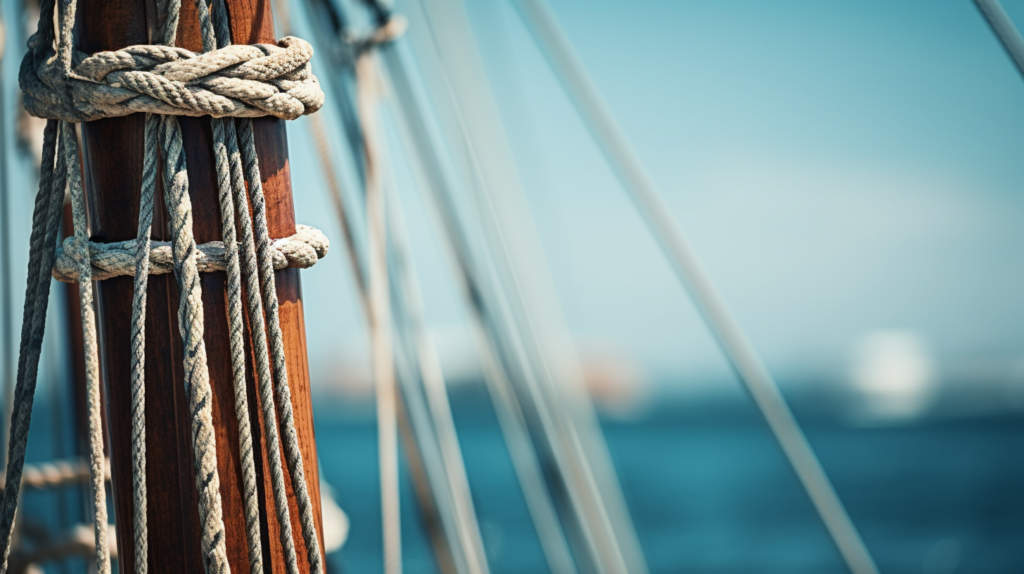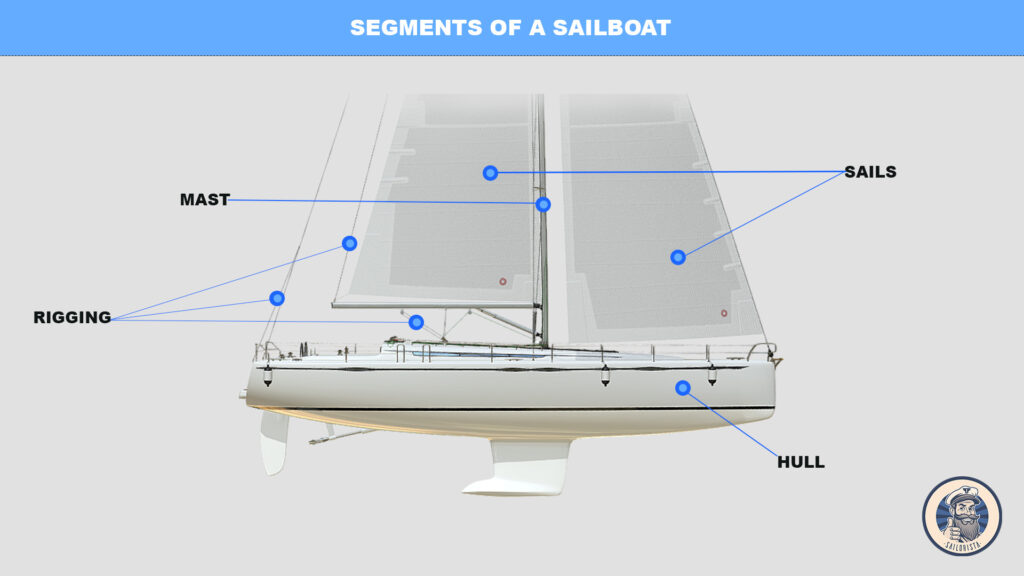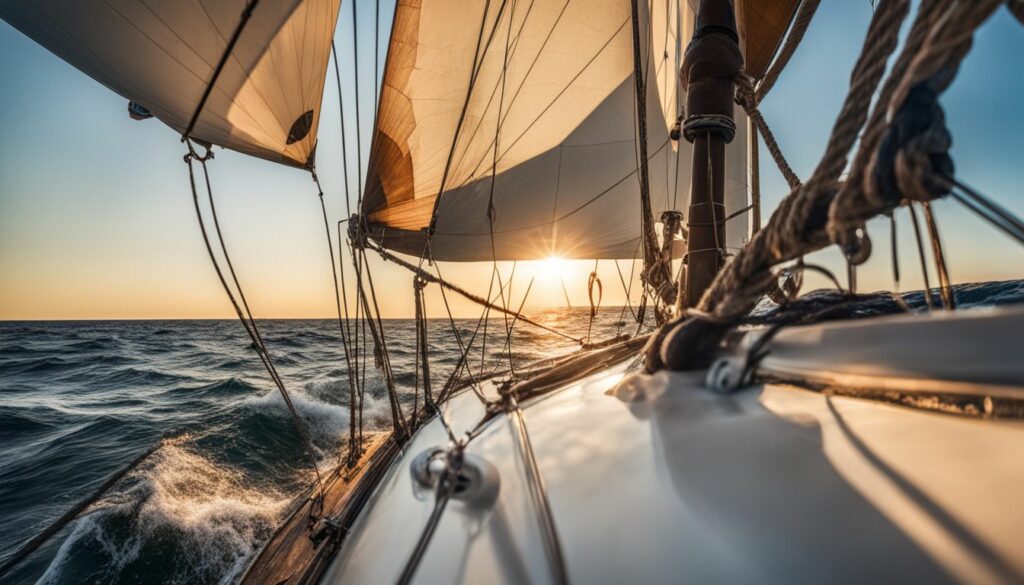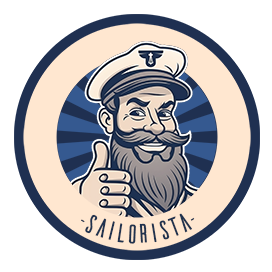Table of Contents
Table of Contents

Ever wondered what all the different parts of a sailboat are called and what they do? In a world where vessels come in all shapes and sizes, understanding basic sailboat components is crucial for novice sailors.
This comprehensive guide will simplify the complex terminologies associated with various parts of a sailboat, from hull to sails. Dive in now, embark on this enlightening journey, and make your sailing dream become reality!
Key Takeaways
- A sailboat has many parts like a hull, mast, sails, and rigging which are important for sailing.
- The hull is the main body of a boat that floats on water. It holds other key elements such as sails and rigging.
- The mast holds up the sails while rigging controls their position.
- Sails catch the wind and move the boat forward. Different types of sails include mainsail, jib, genoa, and spinnaker.
- Rigging ties together all these parts; it’s like an extensive network of cables that helps a sailor control his boat.
- The bow at the front cuts through water while the stern at the back brings stability to the vessel.
- Other important components include a transom, bilge (which collects excess water), keel (that prevents sideways drift), and rudder (for steering) along with a deck where various tools needed for navigation rest.
- Learning about all these sailboat components can make your experience easier when you go out to sail!
The Different Segments of a Sailboat.

Understanding the different segments of a sailboat is essential for every sailor. The hull forms the main body of your boat, touching the water. The mast stands tall on the deck and holds the sails.
Sails are made of durable material that catches wind to propel your sailboat forward. Lastly, rigging comprises ropes or chains used to adjust the position of these sails – enabling smooth navigation on the water.
Hull
The hull, a key pillar of any sailboat, maintains buoyancy and houses several vital components such as sails and rigging. Diverse parts make up the hull: the deck, keel, cabin, waterline, bilge, bow (front), stern (back), rudder along with port (left) and starboard (right).
This accommodating structure is not just foundational for boat stability in diverse water conditions but also provides an essential space to secure other major sailing equipment.
Mast
The mast dominates the skyline of every sailboat, playing a central role in its structure and function. This tall pole serves as the skeleton for the sails, defining their shape and determining their performance.
The largest sail on any given boat, known as the mainsail, is attached to this sturdy component.
Additionally, various parts of the rigging connect to it; these cables or ropes control the position of the sails and help steer the boat along with rudder action. Sailors make fine adjustments to these connections based on wind conditions and desired direction – an art form learned through experience at sea.
The design and size of a mast vary greatly depending on the type of sailboat but always carry out critical operations in ensuring smooth sailing.
Sails
The sails play a crucial role in operating a sailboat, capturing the wind to propel the boat forward. Known as one of the main parts of a sailboat, these elements attach to the mast using rigging.
This setup ensures that sailors can secure them tightly and adjust as necessary according to wind conditions. The variety of sails includes mainsail, genoa, jib, and spinnaker with each type serving different functions on broad water travel or precise direction control.
From providing propulsion to playing a key part in navigation, sails are vital for any sailing journey.
Rigging
Rigging is the network of cables, lines, and hardware that connect the sails to the mast. It’s one of the most complex aspects of a sailboat’s anatomy but plays a vital role in moving your boat forward.
The deck houses both deck hardware and rigging, making it an integral part of any sailing adventure. Every sailor needs to understand their rigging system well, as it gives them control over their sails’ positioning and shape, enabling efficient navigation through winds and waters.
The Most Important Parts of a Sailboat

Discover the key parts of a sailboat that play a vital role in its functioning and navigation, including the bow, stern, transom, bilge, waterline, deck, keel, and rudder. Hang tight as we take you on an insightful journey through each of these essential components!
Bow
The bow, or the front part of a sailboat, serves a significant role in sailing. Being responsible for cutting through water, is central to maintaining stability and facilitating smooth navigation.
The shape of the bow varies based on the type of boat; they could either be pointed or rounded.
Storage and deployment of anchors mainly happen at the bow area. It also holds the navigation lights that enhance visibility during night sails. This critical part not only provides structural support but also legitimizes its importance by contributing significantly to controlling speed while sailing.
Stern
The stern acts as the backbone of a sailboat, positioned at the rear end. Known for bringing stability and control, this crucial part of the boat is where you’ll find the rudder attached.
This setup allows sailors to efficiently steer and maneuver their vessels in diverse water conditions. Often, the helmsman operates from the stern area to navigate through waves with precision.
The importance of a sturdy and well-functioning stern cannot be overstated in maintaining an ideal sailing experience.
Transom
The transom, a vital part of the sailboat’s hull, ensures structural support and stability. Positioned at the stern, its prime function integrates with the rudder for precise navigation while sailing.
Crafted using durable materials such as fiberglass or wood, it withstands multiple marine conditions efficiently. Some boats even feature a swim platform and boarding ladder on the transom to enable easy water access, enhancing overall functionality.
Bilge
The bilge, found at the lowest point of a sailboat’s hull, plays a crucial role in maintaining the vessel’s buoyancy. It serves as a collection point for any water that finds its way into the boat.
A bilge pump aids in clearing out this collected water, thus preventing potential sinking scenarios. Not just limited to managing excess moisture, this hidden compartment often houses other essential components such as fuel tanks, water tanks, and electrical wiring.
Therefore regular inspection and cleanup is critical not only to prevent accumulation of debris but also for early detection of possible contaminations or leaks from these housed units within it.
Waterline
The waterline is a crucial element of any sailboat. It’s the place where your boat’s hull kisses the surface of the water, acting as a boundary line between floating and sinking. Having an optimal waterline length can contribute to greater stability and faster speeds when sailing.
Moreover, unlike other parts of a sailboat, you have control over your boat’s waterline. A surprising fact about it is that its placement isn’t fixed but varies depending on several factors such as weight distribution and load within the vessel.
By modifying these aspects – adding or removing weight from your sailboat – you can manipulate the positioning of the waterline hence affecting overall performance while at sea.
Deck
The deck of a sailboat is the top part of the boat’s hull, standing as an essential platform for various equipment and activities. On this surface, you can find indispensable hardware such as pulpit, stanchions, mainsheet traveler, winches, compass, chart plotter, outboard motor, and anchors.
Sailors rely on this secure area to navigate the waters effectively with tools like the compass and chart plotter while also managing the sails using pulpit or winches. The well-placed deck components make sailing smoother by facilitating functions from hoisting sails to calculating boat positioning.
Every inch of your sailboat’s deck serves a purpose in ensuring safe and successful voyages at sea.
Keel
The keel plays a crucial role in maintaining the balance of your sailboat. Acting as a large fin, it is situated at the bottom of the hull to prevent sideways drift and enhance upwind performance.
Keels come in different shapes and designs tailored for various boat types and uses. Constructed from heavy materials like lead or iron, they ensure that your vessel stays upright even under strong winds, stopping any potential capsizing before it happens.
Innovations in keel design contribute greatly to sailboats’ stability and efficiency today.
Rudder
The rudder, a pivotal component of every sailboat, stands at the stern. It primarily works as your steering wheel on the water, guiding you toward your desired direction. Constructed as a flat plate or foil, it is connected to the boat via a hinge allowing for fluid motion on demand.
Sails and wind work in harmony with the rudder’s movements to deliver precision control over where you want your vessel to go. For enhanced maneuverability during turns, adjusting the angle of the rudder proves beneficial.
No matter how calm or turbulent the waters might be, trust in this crucial part to keep the course true.
Different Types of Sails
Delve into the world of sails as we explore various types like mainsails, genoas, jibs, and spinnakers. Each unique design and function has its dedicated role on a sailboat. Stick around to learn how these fascinating components contribute to your sailing adventure!
Mainsail
A sailboat isn’t complete without its mainsail. This colossal part, known as the most significant sail on a boat, plays an indispensable role in propulsion. It’s cleverly mounted to the mast through a complex system of rigging — an arrangement involving lines, cables, spars, and added hardware.
The boom, which is essentially a horizontal pole attached to the mast, ensures that the mainsail maintains its position firmly. With every gust of wind captured by this exceptional component comes increased momentum for your vessel! So next time you’re out at sea appreciating your sailboat’s agility and gracefulness in maneuvering through waves – don’t forget; that it’s all thanks to your sturdy mainsail!
Genoa
Genoa sails are crucial components of modern sailboats, designed to capture and harness the power of wind. These sails attach directly to the mast using a set of rigging composed of lines, cables, spars, and hardware.
Their primary function is providing propulsion for the boat through expertly managing airflow. Depending on your type of vessel or sailing preference, you may encounter Genoa in either single or double-sail configurations.
Regardless of their setup, all Genoa sails serve as vital elements in propelling a sailboat across wide expanses of water effectively and efficiently.
Jib
The jib is an integral part of a sailboat’s rigging system. Positioned forward of the mast, this standard-sized headsail on a Bermuda Sloop rig plays a crucial role in capturing wind and providing propulsion for the boat.
The sail is attached to the mast via carefully arranged lines, cables, spars, and hardware that compose the vessel’s intricate rigging network. Not only does it contribute significantly to propelling the boat, but when combined with other sails, it imparts to the sailboat its classic appearance.
Mastering control of your jib can make sailing more efficient and enjoyable!
Spinnaker
The Spinnaker serves as a secret weapon for many sailors. This type of sail, specifically designed for downwind sailing, can considerably amplify the speed of a sailboat. Picture it as if you’re holding an umbrella open against the wind to move swiftly – that analogy sums up how Spinnaker works when powering a boat.
Sailing aficionados employ this specialty sail strategically alongside two primary sails on most modern vessels. The rigging plays an instrumental role in attaching the Spinnaker to the mast; it involves using lines, cables, spars, and hardware flawlessly interconnected.
Don’t underestimate this splashy piece of triangular cloth; its potential contribution to your journey is immense!
Understanding Rigging
Understanding rigging is crucial in sailing, as it keeps the mast upright and positions the sails correctly. The standing rigging includes essential parts like shrouds and stays that provide stability to the sailboat’s mast.
Running rigging, on the other hand, consists of lines used for raising, lowering, and adjusting sails. Recognizing common rope terminology can also speed up your navigation processes onboard.
Standing Rigging
Standing rigging is made up of several essential components including shrouds, stays, and forestays. This vital part of a sailboat’s structure works to support the mast, ensuring stability while out on the water.
Consider it as a system that distributes forces from sails directly to the hull. That way, balance and overall performance on your sailing journey are maintained effectively. From keeping the mast upright to adjusting its angle relative to the deck, every aspect of standing rigging contributes crucially towards efficient sailing.
Running Rigging
Running rigging plays a crucial role in operating the sails of a sailboat. This system comprises lines, cables, spars, and hardware that give you control over the sails, facilitating propulsion.
Unlike standing rigging designed to support the mast, running rigging adjusts according to wind conditions for optimal maneuverability. Notably, modern sailboats encompass multiple lines and cables creating an intricate running rigging mechanism.
With such complexity comes versatility in sailing experiences under diverse weather patterns and wind strengths.
Common Rope Terminology
Understanding common rope terminology is an integral part of sailboat operation. Words like ‘bight’, ‘coil’, and ‘hitch’ are not just sailor talk; they designate specific types of rope usage on a boat.
For example, a bight refers to any curved section or slack part between the ends of a line. A coil is how you should neatly arrange your rope when it’s idle to avoid knots and tripping hazards.
On the other hand, hitch refers to temporary knots used frequently to fasten a line securely around various objects such as rails or hooks without getting it shackled permanently. Terms like these help sailors communicate efficiently and operate their vessels safely amid complex rigging systems.
Understanding this language helps you maintain order while sailing, ensures the correct use of the equipment, and allows for smooth communication among crew members aboard.
Essential Hardware on a Sailboat
Discover the fundamental hardware on a sailboat from deck accessories, mainsheet travelers, and winches to compasses, chart plotters, and anchors. Read more to unveil how these critical components come together to make your sailing dream come alive!
Deck Hardware
Deck Hardware enhances the functionality and safety of a sailboat. It includes:
- Pulpit: A safety railing at the front of the boat prevents people from falling off.
- Stanchions: Vertical poles that offer support to lifelines, providing additional safety on deck.
- Mainsheet Traveler: This adjustable track across the deck allows sailors to control the angle and tension of the mainsail for optimal wind capture.
- Winches: These mechanical tools help manage rigging tensions and adjust sails, crucial for navigating different wind conditions.
- Compass: Essential for navigation, it helps sailors remain oriented in open waters.
- Chartplotter: An advanced device combining GPS signals with electronic navigational charts to display your boat’s position in real-time.
- Outboard Motor: Provides propulsion for smaller boats or auxiliary power for larger vessels when winds are low or non-existent.
- Anchors: Used to secure a boat in place, preventing it from drifting due to currents or winds.
Mainsheet Traveler
The Mainsheet Traveler holds a key role in optimizing the performance of your sailboat. Found on the deck, it adjusts the angle and position of the mainsail for optimized shape and performance.
This hardware consists of a track or rail along which a car or block moves. This movable part is where you attach the mainsheet controlling the mainsail’s motion. Hence, understanding how to adjust your mainsheet traveler can drastically improve your sailing experience by allowing precise control over your boat’s speed and direction.
Winches
Winches serve a vital role on any sailboat—controlling and adjusting the tension of lines and sails. These mechanisms can be found mounted on the deck or cockpit, making them easily accessible to sailors.
To operate a winch, turn a handle or employ a power-driven system.
The size and number of winches onboard vary according to the type and size of the boat. It’s undeniable that these compact devices greatly influence both power and performance when sailing.
Whether guiding hefty mainsails or managing trim lines on smaller vessels, winches are irreplaceable tools in optimal sailboat functionality.
Compass
The compass, a key component of the sailboat’s deck hardware, plays an indispensable role in successful sailing adventures. It serves as a reliable directional tool that helps sailors plot their course and detect wind direction changes.
By aligning with Earth’s magnetic field, the compass’s magnetic needle points toward accurate directions necessary for optimal navigation. For seamless use and reference during sailing voyages, it is usually mounted at a readily visible spot on the boat’s deck.
Dependable and practical, the nautical compass ensures smoother, safer journeys on water bodies worldwide by providing consistent guidance to sailors.
Chartplotter
Navigating the open waters becomes a breeze with a chartplotter. This essential device serves as your guide on the sea, providing real-time data about your boat’s location, direction, and speed.
It displays digital charts and routes to aid sailors in mapping their journey accurately. Whether you’re crossing vast oceans or exploring coastal lines, the chartplotter keeps an eye on your progress while monitoring surrounding areas for safety purposes.
So, get ready to steer clear of obstacles and sail towards adventure with this crucial piece of hardware onboard!
Outboard Motor
Outboard motors revolutionize the sailboat experience by providing necessary propulsion when winds aren’t playing nice. These essential pieces of equipment attach to the stern, giving power on demand.
Fueled by gasoline or diesel, they come in various sizes to match your boat and sailing needs. One standout feature of outboard motors is their portability which allows for easy removal and storage when it’s time for a pure wind-driven journey.
Anchors
Anchors play a crucial role in the world of sailing. They are designed to keep a sailboat securely positioned when there’s no need for sailing. Anchors offer stability and act as shields against drifting, particularly under harsh wind conditions or strong currents.
There is an array of anchors one can choose from, each matching different criteria. Plow anchors, fluke anchors, and claw anchors are among the most common types used by sailors worldwide.
The selection process involves considering factors such as the seabed type, prevailing weather conditions, along the boat size itself. Many sailors carry multiple varieties to deal with various situations or serve as replacements if required.
Conclusion
Sailboats are intricate marvels of design and engineering. Mastering the components and their functions is essential for any sailor. With this comprehensive guide, you’re now equipped with knowledge about the different sailboat parts.
Let’s set sail on your sailing journey!
Related Articles
https://www.sailorista.com/how-to-take-down-the-mast-on-a-sailboat/
FAQ
1. What are the basic parts of a sailboat?
A sailboat consists of several basic parts including the sail, mast, hull, rigging, keel, and rudder.
2. What is the purpose of a sailboat’s mast?
The mast is the vertical pole that supports the sails and provides stability to the sailboat. It acts as the backbone of the boat.
3. What is the role of the keel in a sailing vessel?
The keel is a fin-like structure attached to the bottom of the hull, which provides stability to the sailboat and helps to prevent it from capsizing.
4. What is the function of the hull on a sailboat?
The hull is the main part of the boat that provides buoyancy and supports the entire structure. It also helps to determine the speed and maneuverability of the sailboat.
5. What is rigging?
Rigging refers to the system of ropes, wires, and hardware used to control the sails and other parts of the sailboat. It includes the shrouds, stays, halyards, and various fittings.
6. What are the different types of sails used on a sailing yacht?
A sailboat typically has a mainsail and a jib sail. The mainsail is attached to the mast and is the primary source of power, while the jib is a smaller sail in front of the mast that helps with steering and balance.
7. What is the purpose of the rudder?
The rudder is a flat, vertical board located at the stern of the sailboat. It is used to steer the boat by controlling the flow of water around it.
8. What is a boom vang?
A boom vang is a line or a mechanism used to control the shape and tension of the mainsail. It helps to keep the boom (horizontal spar) in place and prevent it from rising too high.
9. What is a topping lift?
A topping lift is a line that supports the aft end of the boom when the mainsail is not in use. It helps to keep the boom elevated and prevents it from dropping or swinging freely.
10. What is the port side of a sailing boat?
The port side is the left side of the boat when facing forward. It is denoted by a red light during night navigation.
11. Does the sailboat keel affect steering the boat?
Yes, the sailboat keel does affect steering. The keel is a heavy, vertical fin-like structure attached to the bottom of the hull. It provides stability and counteracts the lateral force of the wind against the sails. The shape and position of the keel help the sailboat maintain a straight course and prevent it from drifting sideways. Additionally, the keel also acts as a centerboard, preventing the boat from being pushed sideways by the water.
12. How does the jib affect the boat?
The jib is a forward sail that helps in controlling the boat’s direction and speed. By adjusting the jib’s position and tension, sailors can fine-tune the balance of the boat and optimize its performance. The jib pushes the boat forward and helps maintain stability by counteracting the force generated by the mainsail.
13. How does the mainsail affect the boat?
The mainsail is the primary driving force behind the boat’s movement. It catches the wind and propels the boat forward. By adjusting the mainsail’s shape and trim, sailors can control the amount of power generated, speed, and direction of the boat. The mainsail is crucial for harnessing the wind’s energy and propelling the boat efficiently.
14. How does the stern affect the boat?
The stern is the rear part of the boat and plays a significant role in its overall stability and maneuverability. The design and shape of the stern impact how the boat handles waves, turns, and changes in direction. A well-designed stern ensures better control, and smoother rides, and prevents excessive rocking or instability.
15. How does the hull affect the boat?
The hull is the body of the boat and directly affects its buoyancy, stability, and speed. Different hull shapes and designs are suitable for specific purposes, such as planning hulls for speed or displacement hulls for stability. The hull’s material and construction also impact the boat’s overall performance and durability.
16. How does the keel affect the boat?
The keel is a fin-like structure attached to the bottom of the boat’s hull, extending downward into the water. It provides stability and prevents the boat from being pushed sideways by the wind. The keel acts as a counterbalance to the sails’ force and helps maintain the boat’s course, especially when sailing upwind.
17. How does the rudder affect the boat?
The rudder is a movable device located at the stern of the boat and is responsible for steering and changing the boat’s direction. By controlling the angle of the rudder, sailors can control the direction of
18. What are the different types of rigging on a sailboat?
Sailboats can have various types of rigging, each serving specific purposes. The most common types include sloop rigging (single mast with one main sail and one jib), cutter rigging (single mast with one main sail and two head sails), and ketch rigging (two masts with a main sail on the main mast and a smaller mizzen mast).
19. What is the centerline of a sailboat?
The centerline of a sailboat is an imaginary line running from the bow (front) to the stern (back) of the boat, dividing it into two equal halves. It represents the boat’s balance and symmetry and is crucial for stability and performance. The centerline is where you’ll find the keel, which helps keep the boat upright by countering the force of the wind on the sails.
20. What is the main part of a sailboat?
The main part of a sailboat typically refers to the central structure or component that plays a pivotal role in the boat’s operation. In many sailboats, the main part is the mast, as it supports the main sail and provides vertical height for the sails to catch the wind.
21. What is a fin in the context of sailing?
In sailing, a fin often refers to the keel or a similar underwater appendage that extends from the hull of the sailboat. The fin serves multiple functions, including providing stability by countering the force of the wind, preventing the boat from drifting sideways, and improving upwind sailing performance.
22. How does the main sail impact a sailboat’s performance?
The main sail is a critical component of a sailboat’s rigging. Its size and shape play a significant role in harnessing the wind’s energy to propel the boat forward. Properly adjusting the main sail’s position and tension is essential for achieving optimal sailboat performance, including speed and maneuverability.
23. What is a spar on a sailboat?
A spar on a sailboat refers to a specific type of structural component that plays a crucial role in the boat’s rigging and sail control. Spars are typically long, slender poles or beams used to support sails and rigging. The two main types of spars found on sailboats are the mast, which is the vertical spar that holds the sails aloft, and the boom, which is the horizontal spar attached to the bottom of the mainsail. Spars are essential for controlling the shape and position of the sails, which, in turn, affects the sailboat’s speed and direction.

